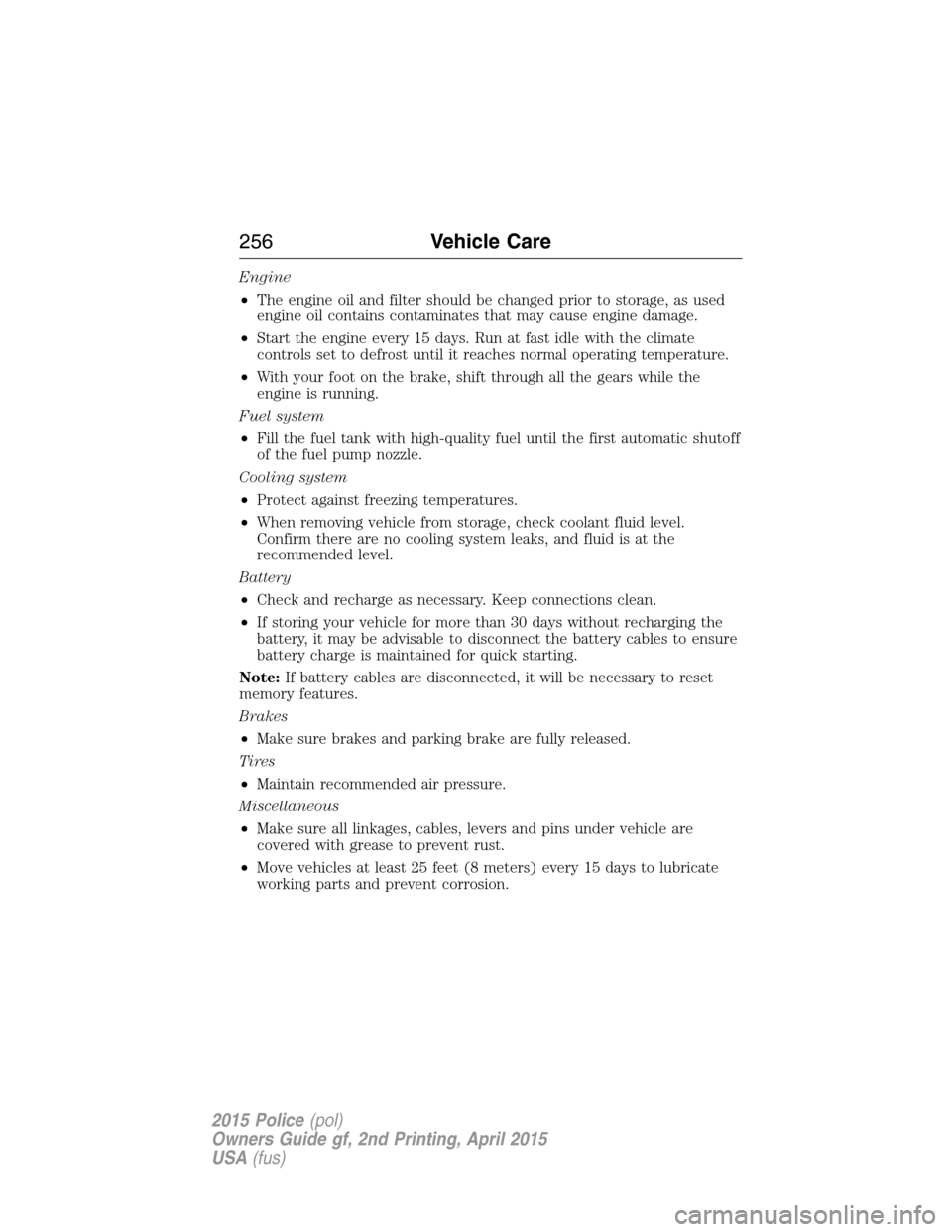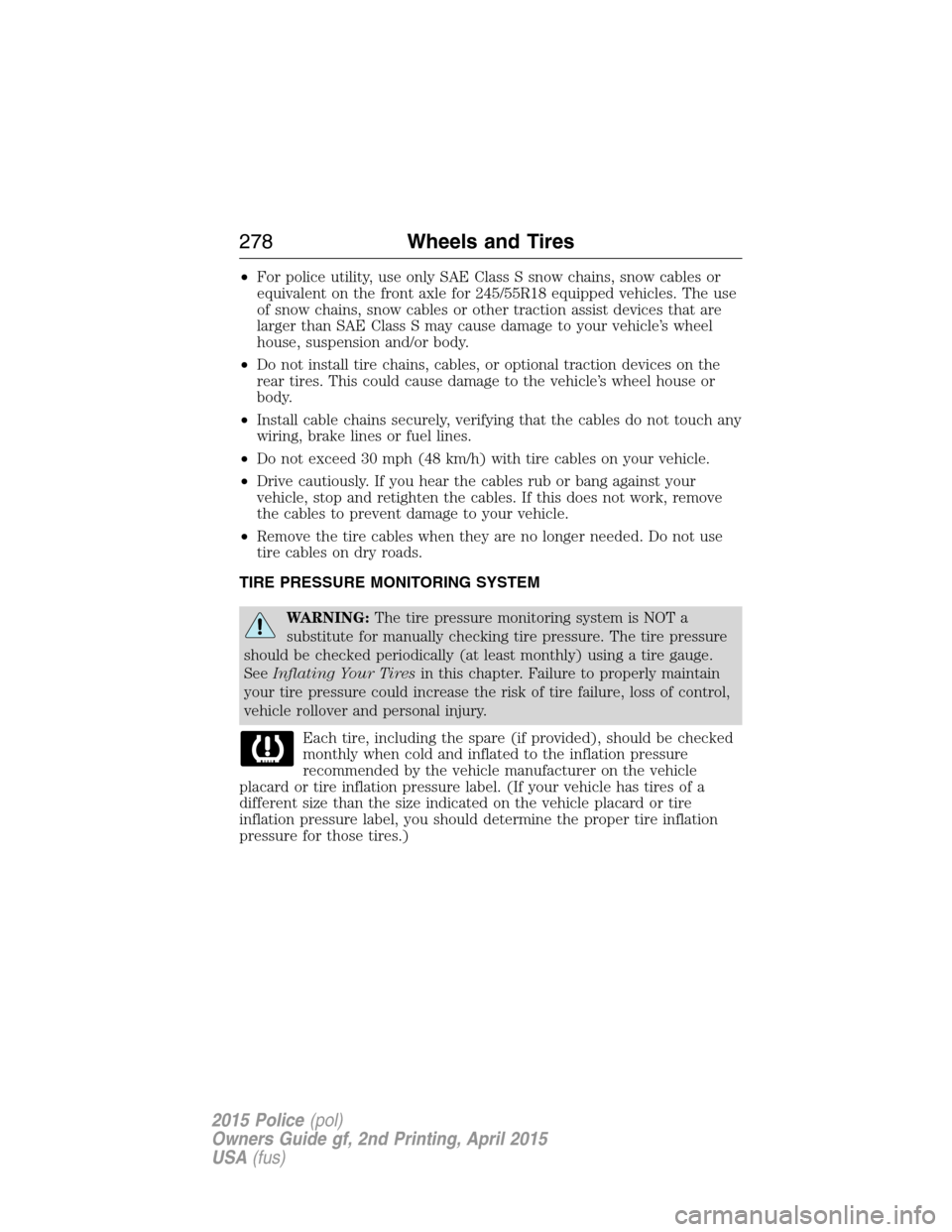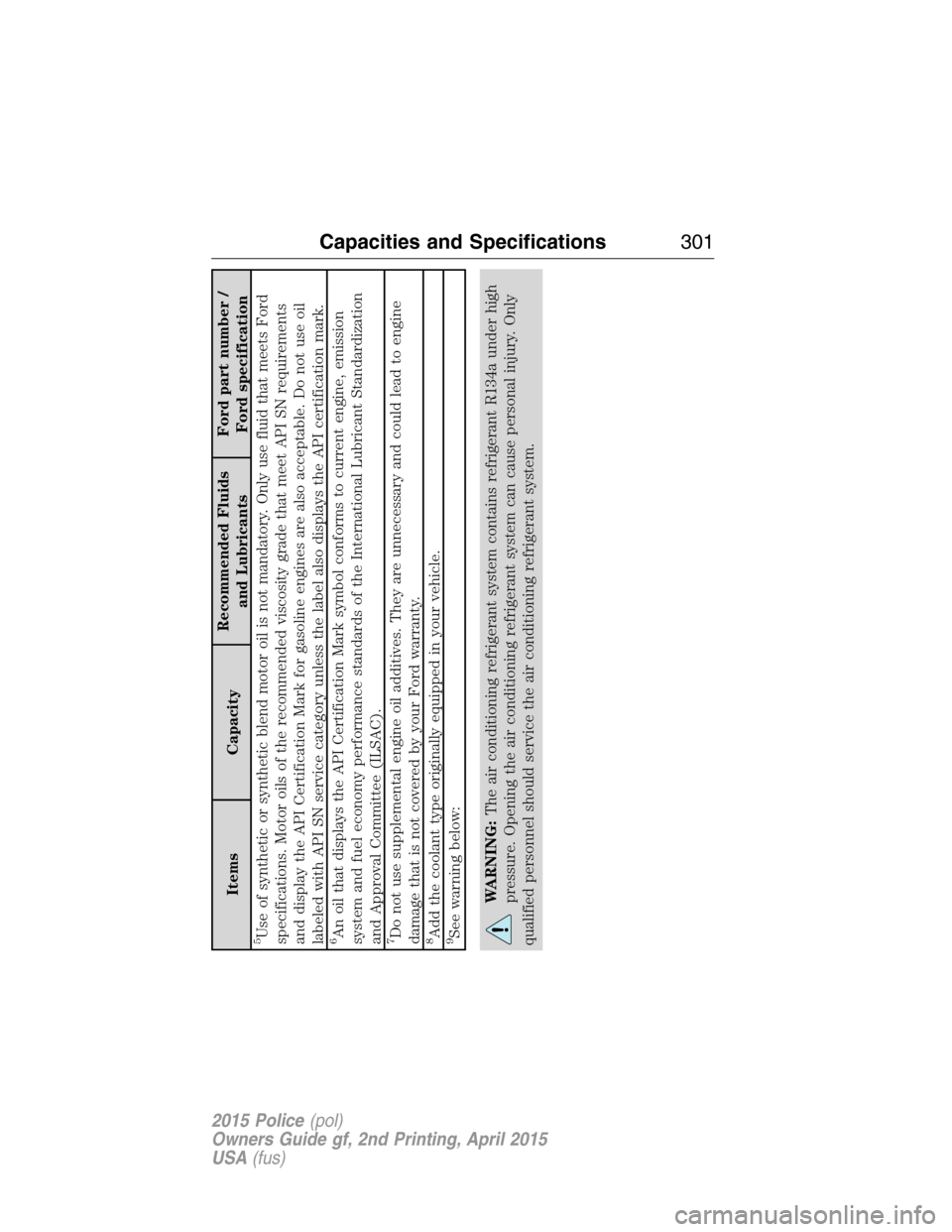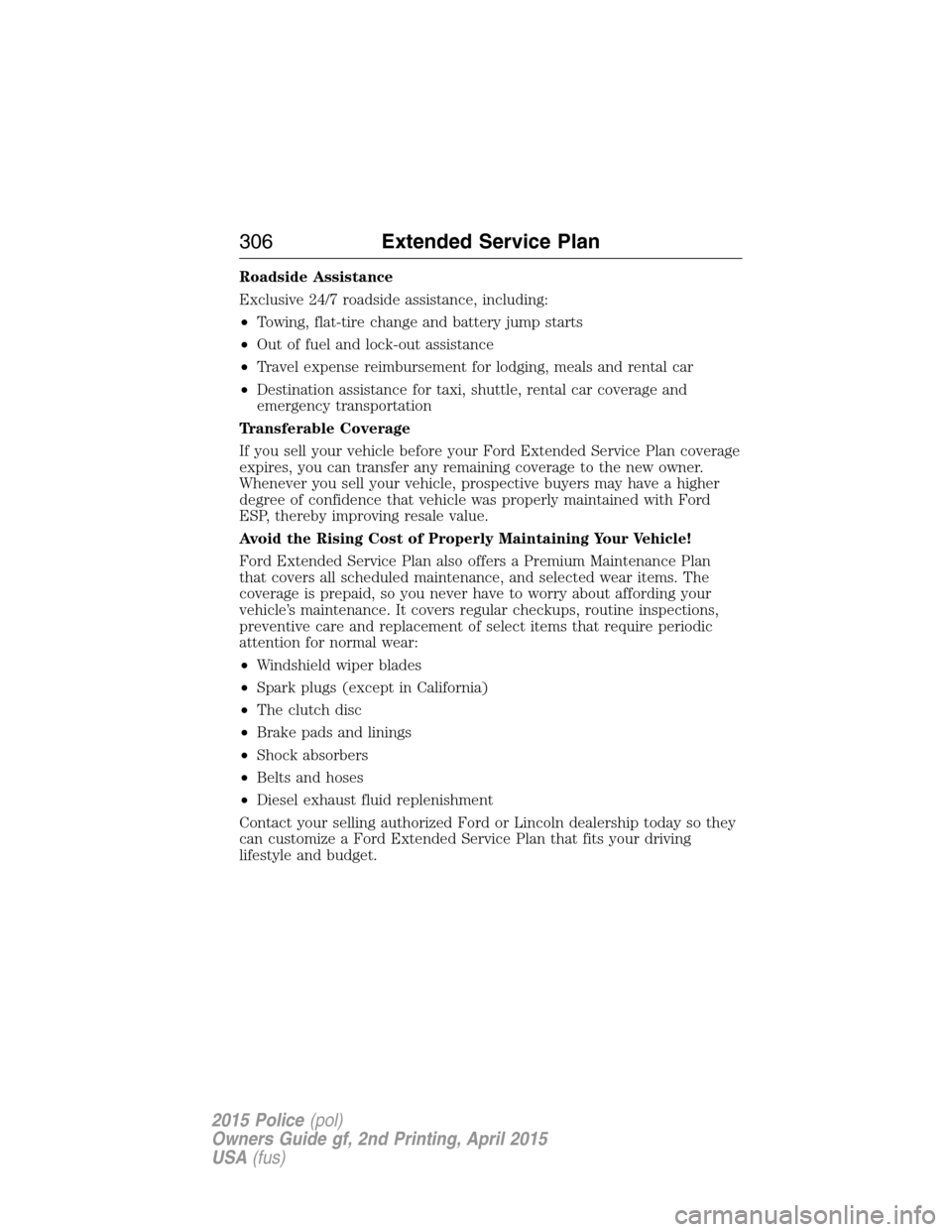Page 257 of 401

Engine
•The engine oil and filter should be changed prior to storage, as used
engine oil contains contaminates that may cause engine damage.
•Start the engine every 15 days. Run at fast idle with the climate
controls set to defrost until it reaches normal operating temperature.
•With your foot on the brake, shift through all the gears while the
engine is running.
Fuel system
•Fill the fuel tank with high-quality fuel until the first automatic shutoff
of the fuel pump nozzle.
Cooling system
•Protect against freezing temperatures.
•When removing vehicle from storage, check coolant fluid level.
Confirm there are no cooling system leaks, and fluid is at the
recommended level.
Battery
•Check and recharge as necessary. Keep connections clean.
•If storing your vehicle for more than 30 days without recharging the
battery, it may be advisable to disconnect the battery cables to ensure
battery charge is maintained for quick starting.
Note:If battery cables are disconnected, it will be necessary to reset
memory features.
Brakes
•Make sure brakes and parking brake are fully released.
Tires
•Maintain recommended air pressure.
Miscellaneous
•Make sure all linkages, cables, levers and pins under vehicle are
covered with grease to prevent rust.
•Move vehicles at least 25 feet (8 meters) every 15 days to lubricate
working parts and prevent corrosion.
256Vehicle Care
2015 Police(pol)
Owners Guide gf, 2nd Printing, April 2015
USA(fus)
Page 279 of 401

•For police utility, use only SAE Class S snow chains, snow cables or
equivalent on the front axle for 245/55R18 equipped vehicles. The use
of snow chains, snow cables or other traction assist devices that are
larger than SAE Class S may cause damage to your vehicle’s wheel
house, suspension and/or body.
•Do not install tire chains, cables, or optional traction devices on the
rear tires. This could cause damage to the vehicle’s wheel house or
body.
•Install cable chains securely, verifying that the cables do not touch any
wiring, brake lines or fuel lines.
•Do not exceed 30 mph (48 km/h) with tire cables on your vehicle.
•Drive cautiously. If you hear the cables rub or bang against your
vehicle, stop and retighten the cables. If this does not work, remove
the cables to prevent damage to your vehicle.
•Remove the tire cables when they are no longer needed. Do not use
tire cables on dry roads.
TIRE PRESSURE MONITORING SYSTEM
WARNING:The tire pressure monitoring system is NOT a
substitute for manually checking tire pressure. The tire pressure
should be checked periodically (at least monthly) using a tire gauge.
SeeInflating Your Tiresin this chapter. Failure to properly maintain
your tire pressure could increase the risk of tire failure, loss of control,
vehicle rollover and personal injury.
Each tire, including the spare (if provided), should be checked
monthly when cold and inflated to the inflation pressure
recommended by the vehicle manufacturer on the vehicle
placard or tire inflation pressure label. (If your vehicle has tires of a
different size than the size indicated on the vehicle placard or tire
inflation pressure label, you should determine the proper tire inflation
pressure for those tires.)
278Wheels and Tires
2015 Police(pol)
Owners Guide gf, 2nd Printing, April 2015
USA(fus)
Page 280 of 401

As an added safety feature, your vehicle has been equipped with a tire
pressure monitoring system (TPMS) that illuminates a low tire pressure
telltale when one or more of your tires is significantly under-inflated.
Accordingly, when the low tire pressure telltale illuminates, you should
stop and check your tires as soon as possible, and inflate them to the
proper pressure. Driving on a significantly under-inflated tire causes the
tire to overheat and can lead to tire failure. Under-inflation also reduces
fuel efficiency and tire tread life, and may affect the vehicle’s handling
and stopping ability.
Please note that the TPMS is not a substitute for proper tire
maintenance, and it is the driver’s responsibility to maintain correct tire
pressure, even if under-inflation has not reached the level to trigger
illumination of the TPMS low tire pressure telltale.
Your vehicle has also been equipped with a TPMS malfunction indicator
to indicate when the system is not operating properly. The TPMS
malfunction indicator is combined with the low tire pressure telltale.
When the system detects a malfunction, the telltale will flash for
approximately one minute and then remain continuously illuminated.
This sequence will continue upon subsequent vehicle start-ups as long as
the malfunction exists.
When the malfunction indicator is illuminated, the system may not be
able to detect or signal low tire pressure as intended. TPMS malfunctions
may occur for a variety of reasons, including the installation of
replacement or alternate tires or wheels on the vehicle that prevent the
TPMS from functioning properly. Always check the TPMS malfunction
telltale after replacing one or more tires or wheels on your vehicle to
ensure that the replacement or alternate tires and wheels allow the
TPMS to continue to function properly.
The tire pressure monitoring system complies with part 15 of the FCC
rules and with RSS-210 of Industry Canada. Operation is subject to the
following two conditions: (1) This device may not cause harmful
interference, and (2) This device must accept any interference received,
including interference that may cause undesired operation.
Wheels and Tires279
2015 Police(pol)
Owners Guide gf, 2nd Printing, April 2015
USA(fus)
Page 287 of 401
WARNING:To reduce the risk of possible serious injury or
death, do not remove the full size spare tire from the factory
secured location. This location is necessary to achieve police-rated
75 mph (120 km/h) rear impact crash-test performance. Removal
increases the risk of fuel leak in high-speed rear impacts.
Note:Passengers should not remain in the vehicle when the vehicle is
being jacked.
Note:For sedan, only the original equipment tire or 245/55R18 tire with
outer diameter less than 725 millimeters will stow in the tire tub.
Utility
1. Park on a level surface, set the parking brake and activate the hazard
flashers.
2. Place the transmission in park(P)and turn the engine off.
3. Lift the floor cargo cover, then
remove the wing nut that secures
the spare tire by turning it
counterclockwise.
4. Lift and remove the spare tire
from the spare tire well.
286Wheels and Tires
2015 Police(pol)
Owners Guide gf, 2nd Printing, April 2015
USA(fus)
Page 295 of 401
Engine2.0L
EcoBoost
engine3.5L V6
engine3.5L V6
EcoBoost
engine3.7L V6
engine
Cubic
inches122 214
214 227
Required
fuelMinimum
87 octaneMinimum
87 octane or
Ethanol (E-85)Minimum
87 octaneMinimum
87 octane or
Ethanol (E-85)
Firing order 1–3–4–2 1–4–2–5–3–6 1–4–2–5–3–6 1–4–2–5–3–6
Ignition
systemCoil on plug Coil on plug Coil on plug Coil on plug
Spark plug
gap0.027-0.031 in.
(0.70-0.80 mm)0.049-0.053 in.
(1.25-1.35 mm)0.033–0.037 in.
(.85–.95 mm)0.049-0.053 in.
(1.25-1.35 mm)
Compres-
sion ratio9.3:1 10.8:1 10.0:1 10.5:1
Engine drivebelt routing
2.0L EcoBoost engines
294Capacities and Specifications
2015 Police(pol)
Owners Guide gf, 2nd Printing, April 2015
USA(fus)
Page 300 of 401
Items CapacityRecommended Fluids
and LubricantsFord part number /
Ford specification
Fuel tankSedan
19.0 gal (72L)
Utility
18.6 gal (70L)——
Sedan
A/C refrigerant
(Without auxiliary
A/C)
9
2.0L/3.5L GTDI:
1.63 lb (0.74 kg)
Motorcraft R-134a
RefrigerantYN-19 (U.S.)
CYN-16-R (Canada) /
WSH-M17B19-A 3.5L/3.7L TiVCT
1.81 lb (0.82 kg)
Utility
A/C refrigerant
(Without auxiliary
A/C)
9
3.7L TiVCT:
1.63 lb (0.74 kg)
Motorcraft R-134a
RefrigerantYN-19 (U.S.)
CYN-16-R (Canada) /
WSH-M17B19-A 3.5L GTDI:
2.1 lb (0.95 kg)
Utility
A/C refrigerant
(With auxiliary
A/C)
9
3.7L TiVCT:
2.31 lb (1.04 kg)
Motorcraft R-134a
RefrigerantYN-19 (U.S.);
CYN-16-R (Canada) /
WSH-M17B19-A 3.5L GTDI
2.94 lb (1.33 kg)
Capacities and Specifications299
2015 Police(pol)
Owners Guide gf, 2nd Printing, April 2015
USA(fus)
Page 302 of 401

Items CapacityRecommended Fluids
and LubricantsFord part number /
Ford specification
5Use of synthetic or synthetic blend motor oil is not mandatory. Only use fluid that meets Ford
specifications. Motor oils of the recommended viscosity grade that meet API SN requirements
and display the API Certification Mark for gasoline engines are also acceptable. Do not use oil
labeled with API SN service category unless the label also displays the API certification mark.6An oil that displays the API Certification Mark symbol conforms to current engine, emission
system and fuel economy performance standards of the International Lubricant Standardization
and Approval Committee (ILSAC).7Do not use supplemental engine oil additives. They are unnecessary and could lead to engine
damage that is not covered by your Ford warranty.8Add the coolant type originally equipped in your vehicle.9See warning below:
WARNING:The air conditioning refrigerant system contains refrigerant R134a under high
pressure. Opening the air conditioning refrigerant system can cause personal injury. Only
qualified personnel should service the air conditioning refrigerant system.
Capacities and Specifications301
2015 Police(pol)
Owners Guide gf, 2nd Printing, April 2015
USA(fus)
Page 307 of 401

Roadside Assistance
Exclusive 24/7 roadside assistance, including:
•Towing, flat-tire change and battery jump starts
•Out of fuel and lock-out assistance
•Travel expense reimbursement for lodging, meals and rental car
•Destination assistance for taxi, shuttle, rental car coverage and
emergency transportation
Transferable Coverage
If you sell your vehicle before your Ford Extended Service Plan coverage
expires, you can transfer any remaining coverage to the new owner.
Whenever you sell your vehicle, prospective buyers may have a higher
degree of confidence that vehicle was properly maintained with Ford
ESP, thereby improving resale value.
Avoid the Rising Cost of Properly Maintaining Your Vehicle!
Ford Extended Service Plan also offers a Premium Maintenance Plan
that covers all scheduled maintenance, and selected wear items. The
coverage is prepaid, so you never have to worry about affording your
vehicle’s maintenance. It covers regular checkups, routine inspections,
preventive care and replacement of select items that require periodic
attention for normal wear:
•Windshield wiper blades
•Spark plugs (except in California)
•The clutch disc
•Brake pads and linings
•Shock absorbers
•Belts and hoses
•Diesel exhaust fluid replenishment
Contact your selling authorized Ford or Lincoln dealership today so they
can customize a Ford Extended Service Plan that fits your driving
lifestyle and budget.
306Extended Service Plan
2015 Police(pol)
Owners Guide gf, 2nd Printing, April 2015
USA(fus)